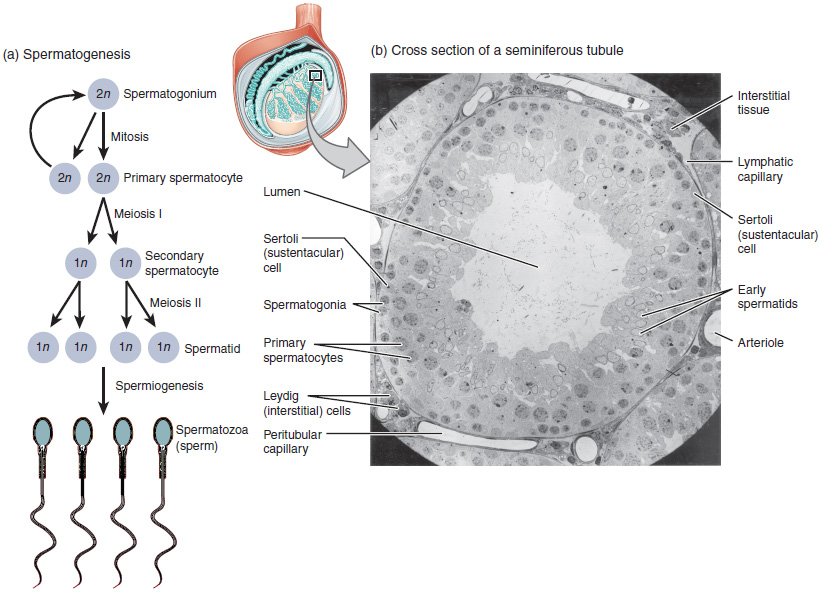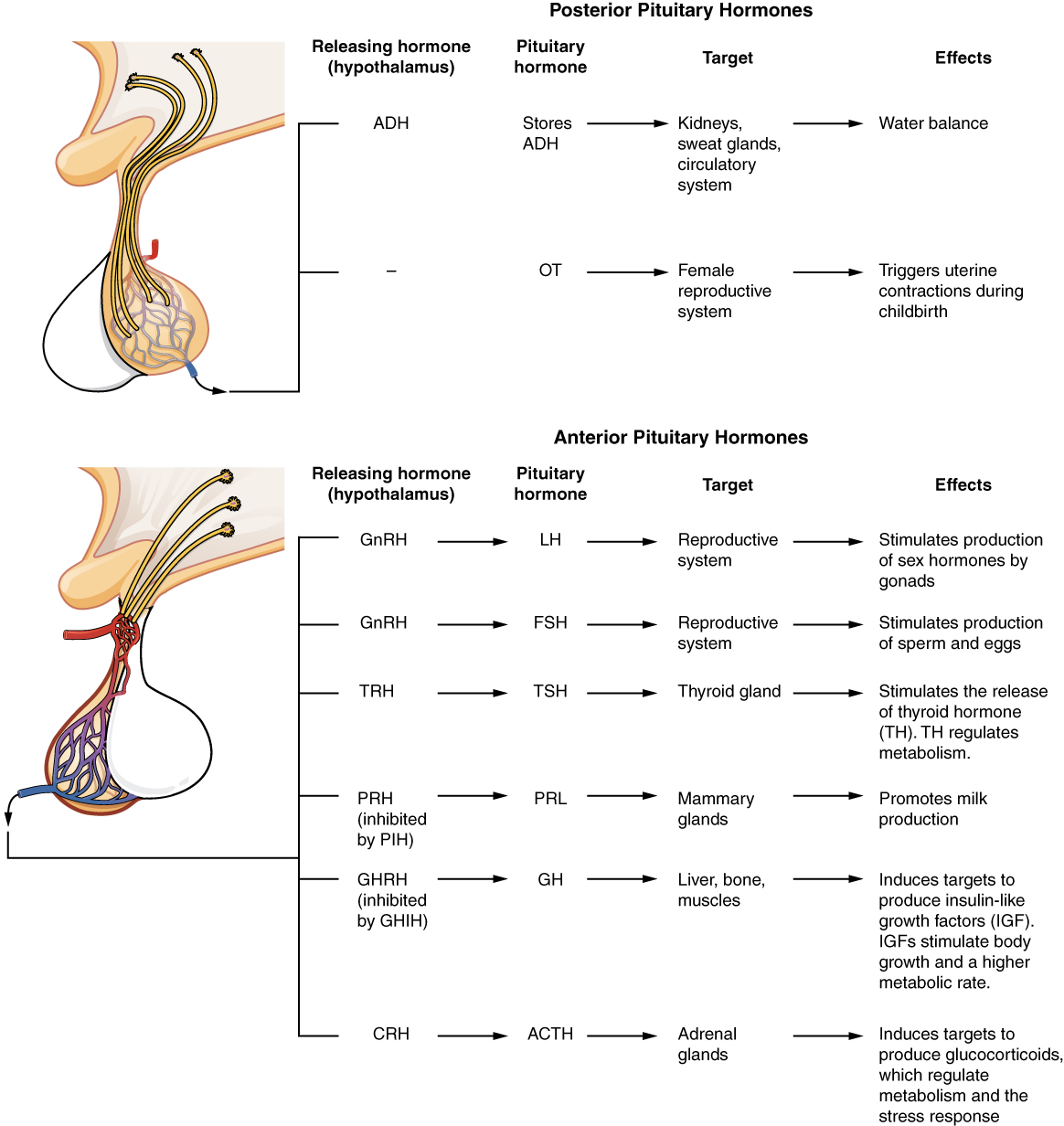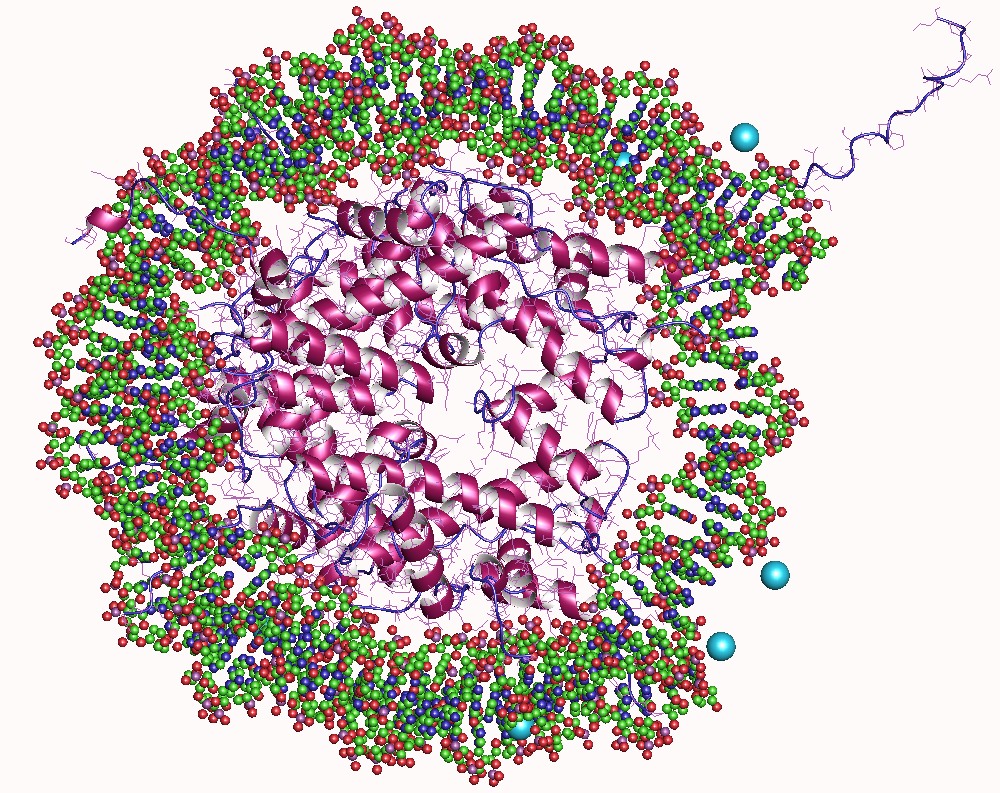|
Spermatogenesis
Spermatogenesis is the process by which haploid spermatozoa develop from germ cells in the seminiferous tubules of the testicle. This process starts with the Mitosis, mitotic division of the stem cells located close to the basement membrane of the tubules. These cells are called Spermatogonial Stem Cells, spermatogonial stem cells. The mitotic division of these produces two types of cells. Type A cells replenish the stem cells, and type B cells differentiate into primary spermatocytes. The primary spermatocyte divides meiotically (Meiosis I) into two secondary spermatocytes; each secondary spermatocyte divides into two equal haploid spermatids by Meiosis II. The spermatids are transformed into spermatozoa (sperm) by the process of spermiogenesis. These develop into mature spermatozoa, also known as sperm, sperm cells. Thus, the primary spermatocyte gives rise to two cells, the secondary spermatocytes, and the two secondary spermatocytes by their subdivision produce four spermatoz ... [...More Info...] [...Related Items...] OR: [Wikipedia] [Google] [Baidu] |
Spermatocyte
Spermatocytes are a type of male gametocyte in animals. They derive from immature germ cells called spermatogonia. They are found in the testis, in a structure known as the seminiferous tubules. There are two types of spermatocytes, primary and secondary spermatocytes. Primary and secondary spermatocytes are formed through the process of spermatocytogenesis. Primary spermatocytes are diploid (2N) cells. After meiosis I, two secondary spermatocytes are formed. Secondary spermatocytes are haploid (N) cells that contain half the number of chromosomes. In all animals, Male, males produce spermatocytes, even hermaphrodites such as Caenorhabditis elegans, ''C. elegans'', which exist as a male or hermaphrodite. In hermaphrodite ''C. elegans'', sperm production occurs first and is then stored in the spermatheca. Once the egg cell, eggs are formed, they are able to self-fertilize and produce up to 350 offspring, progeny. Development At puberty, spermatogonia located along the walls of th ... [...More Info...] [...Related Items...] OR: [Wikipedia] [Google] [Baidu] |
Seminiferous Tubules
Seminiferous tubules are located within the testicles, and are the specific location of meiosis, and the subsequent creation of male gametes, namely spermatozoa. Structure The epithelium of the tubule consists of a type of sustentacular cells known as Sertoli cells, which are tall, columnar type cells that line the tubule. In between the Sertoli cells are spermatogenic cells, which differentiate through meiosis to sperm cells. Sertoli cells function to nourish the developing sperm cells. They secrete androgen-binding protein, a binding protein which increases the concentration of testosterone. There are two types: convoluted and straight, convoluted toward the lateral side, and straight as the tubule comes medially to form ducts that will exit the testis. The seminiferous tubules are formed from the testis cords that develop from the primitive gonadal cords, formed from the gonadal ridge. Function Spermatogenesis, the process for producing spermatozoa, takes place i ... [...More Info...] [...Related Items...] OR: [Wikipedia] [Google] [Baidu] |
Male Infertility
Male infertility refers to a sexually mature male's inability to impregnate a fertile female. Male infertility can wholly or partially account for 40% of infertility among couples who are trying to have children. "A problem with the male is the sole cause, or a contributing cause, of infertility in about 40 percent of infertile couples. It affects approximately 7% of all men. Male infertility is commonly due to deficiencies in the semen, and semen quality is used as a surrogate measure of male fecundity. More recently, advance sperm analyses that examine intracellular sperm components are being developed. Age considerations Sperm motility increases from puberty through one's mid-thirties. Research shows that from the age of 36 onwards, sperm motility decreases from 40% Grade A & B to 31% in one's 50s. The effects of aging on semen quality is summarized below based on a study of 1,219 subjects: 90% of seminiferous tubules in men in their 20s and 30s contain spermatids, whereas ... [...More Info...] [...Related Items...] OR: [Wikipedia] [Google] [Baidu] |
Germ Cell
A germ cell is any cell that gives rise to the gametes of an organism that reproduces sexually. In many animals, the germ cells originate in the primitive streak and migrate via the gut of an embryo to the developing gonads. There, they undergo meiosis, followed by cellular differentiation into mature gametes, either eggs or sperm. Unlike animals, plants do not have germ cells designated in early development. Instead, germ cells can arise from somatic cells in the adult, such as the floral meristem of flowering plants. Introduction Multicellular eukaryotes are made of two fundamental cell types: germ and somatic cells. Germ cells produce gametes and are the only cells that can undergo meiosis as well as mitosis. Somatic cells are all the other cells that form the building blocks of the body and they only divide by mitosis. The lineage of germ cells is called the germline. Germ cell specification begins during cleavage in many animals or in the epiblast during gastr ... [...More Info...] [...Related Items...] OR: [Wikipedia] [Google] [Baidu] |
Spermiogenesis
Spermiogenesis is the final stage of spermatogenesis, during which the spermatids develop into mature spermatozoon, spermatozoa. At the beginning of the stage, the spermatid is a more or less circular cell containing a cell nucleus, nucleus, Golgi apparatus, centriole and mitochondria; by the end of the process, it has radically transformed into an elongated spermatozoon, complete with a head, midpiece, and tail. Phases The process of spermiogenesis is traditionally divided into four stages: the Golgi phase, the cap phase, formation of the tail, and the maturation stage. Golgi phase The spermatids, which up until now have been mostly Symmetry (biology), radially symmetrical, begin to develop polarity. The head forms at one end, where the Golgi apparatus creates enzymes that will become the acrosome. At the other end, it develops a thickened midpiece, where the mitochondria gather and the distal centriole begins to form an axoneme. Spermatid DNA also undergoes packaging, becomi ... [...More Info...] [...Related Items...] OR: [Wikipedia] [Google] [Baidu] |
Oogenesis
Oogenesis () or ovogenesis is the differentiation of the ovum (egg cell) into a cell competent to further develop when fertilized. It is developed from the primary oocyte by maturation. Oogenesis is initiated before birth during embryonic development. Oogenesis in non-human mammals In mammals, the first part of oogenesis starts in the germinal epithelium, which gives rise to the development of ovarian follicles, the functional unit of the ovary. Oogenesis consists of several sub-processes: oocytogenesis, ootidogenesis, and finally maturation to form an ovum (oogenesis proper). Folliculogenesis is a separate sub-process that accompanies and supports all three oogenetic sub-processes. Oogonium —(Oocytogenesis)—> Primary Oocyte —(Meiosis I)—> First Polar body (Discarded afterward) + Secondary oocyte —(Meiosis II)—> Second Polar Body (Discarded afterward) + Ovum Oocyte meiosis, important to all animal life cycles yet unlike all other instances ... [...More Info...] [...Related Items...] OR: [Wikipedia] [Google] [Baidu] |
Histone Modification
In biology, histones are highly basic proteins abundant in lysine and arginine residues that are found in eukaryotic cell nuclei and in most Archaeal phyla. They act as spools around which DNA winds to create structural units called nucleosomes. Nucleosomes in turn are wrapped into 30-nanometer fibers that form tightly packed chromatin. Histones prevent DNA from becoming tangled and protect it from DNA damage. In addition, histones play important roles in gene regulation and DNA replication. Without histones, unwound DNA in chromosomes would be very long. For example, each human cell has about 1.8 meters of DNA if completely stretched out; however, when wound about histones, this length is reduced to about 9 micrometers (0.09 mm) of 30 nm diameter chromatin fibers. There are five families of histones, which are designated H1/H5 (linker histones), H2, H3, and H4 (core histones). The nucleosome core is formed of two H2A-H2B dimers and a H3-H4 tetramer. The tight wrappi ... [...More Info...] [...Related Items...] OR: [Wikipedia] [Google] [Baidu] |
Gamete
A gamete ( ) is a Ploidy#Haploid and monoploid, haploid cell that fuses with another haploid cell during fertilization in organisms that Sexual reproduction, reproduce sexually. Gametes are an organism's reproductive cells, also referred to as sex cells. The name gamete was introduced by the German cytologist Eduard Strasburger in 1878. Gametes of both mating individuals can be the same size and shape, a condition known as isogamy. By contrast, in the majority of species, the gametes are of different sizes, a condition known as anisogamy or heterogamy that applies to humans and other mammals. The human ovum has approximately 100,000 times the volume of a single human sperm cell. The type of gamete an organism produces determines its sex and sets the basis for the sexual roles and sexual selection. In humans and other species that produce two Morphology (biology), morphologically distinct types of gametes, and in which Gonochorism, each individual produces only one type, a femal ... [...More Info...] [...Related Items...] OR: [Wikipedia] [Google] [Baidu] |
Spermatozoon
A spermatozoon (; also spelled spermatozoön; : spermatozoa; ) is a motile sperm cell (biology), cell produced by male animals relying on internal fertilization. A spermatozoon is a moving form of the ploidy, haploid cell (biology), cell that is the male gamete that Fertilization, joins with an ovum to form a zygote. (A zygote is a single cell, with a complete set of chromosomes, that normally develops into an embryo.) Sperm cells contribute approximately half of the nuclear gene, genetic information to the diploid offspring (excluding, in most cases, mitochondrial DNA). In mammals, the sex of the offspring is determined by the sperm cell: a spermatozoon bearing an X chromosome will lead to a female (XX) offspring, while one bearing a Y chromosome will lead to a male (XY) offspring. Sperm cells were first observed in Antonie van Leeuwenhoek's laboratory in 1677. Mammalian spermatozoa Humans The sperm cell of ''Homo sapiens'' is the small Gamete, reproductive cell produced by m ... [...More Info...] [...Related Items...] OR: [Wikipedia] [Google] [Baidu] |
Spermatogonial Stem Cells
A spermatogonial stem cell (SSC), also known as a type A spermatogonium, is a spermatogonium that does not differentiate into a spermatocyte, a precursor of sperm cells. Instead, they continue dividing into other spermatogonia or remain dormant to maintain a reserve of spermatogonia. Type B spermatogonia, on the other hand, differentiate into spermatocytes, which in turn undergo meiosis to eventually form mature sperm cells. Spermatogonial stem cells in the testis During fetal development, gonocytes develop from primordial germ cells, and following this SSCs develop from gonocytes in the testis. SSCs are the early precursor for spermatozoa and are responsible for the continuation of spermatogenesis in adult mammals. The stem cells are capable of dividing into more SSCs which is vital for maintaining the stem cell pool. Alternatively, they go on to differentiate into spermatocytes, spermatids, and finally spermatozoa. One SSC is the precursor for multiple spermatozoa and ther ... [...More Info...] [...Related Items...] OR: [Wikipedia] [Google] [Baidu] |
Sexual Reproduction
Sexual reproduction is a type of reproduction that involves a complex life cycle in which a gamete ( haploid reproductive cells, such as a sperm or egg cell) with a single set of chromosomes combines with another gamete to produce a zygote that develops into an organism composed of cells with two sets of chromosomes ( diploid). This is typical in animals, though the number of chromosome sets and how that number changes in sexual reproduction varies, especially among plants, fungi, and other eukaryotes. In placental mammals, sperm cells exit the penis through the male urethra and enter the vagina during copulation, while egg cells enter the uterus through the oviduct. Other vertebrates of both sexes possess a cloaca for the release of sperm or egg cells. Sexual reproduction is the most common life cycle in multicellular eukaryotes, such as animals, fungi and plants. Sexual reproduction also occurs in some unicellular eukaryotes. Sexual reproduction does not occur in pro ... [...More Info...] [...Related Items...] OR: [Wikipedia] [Google] [Baidu] |





